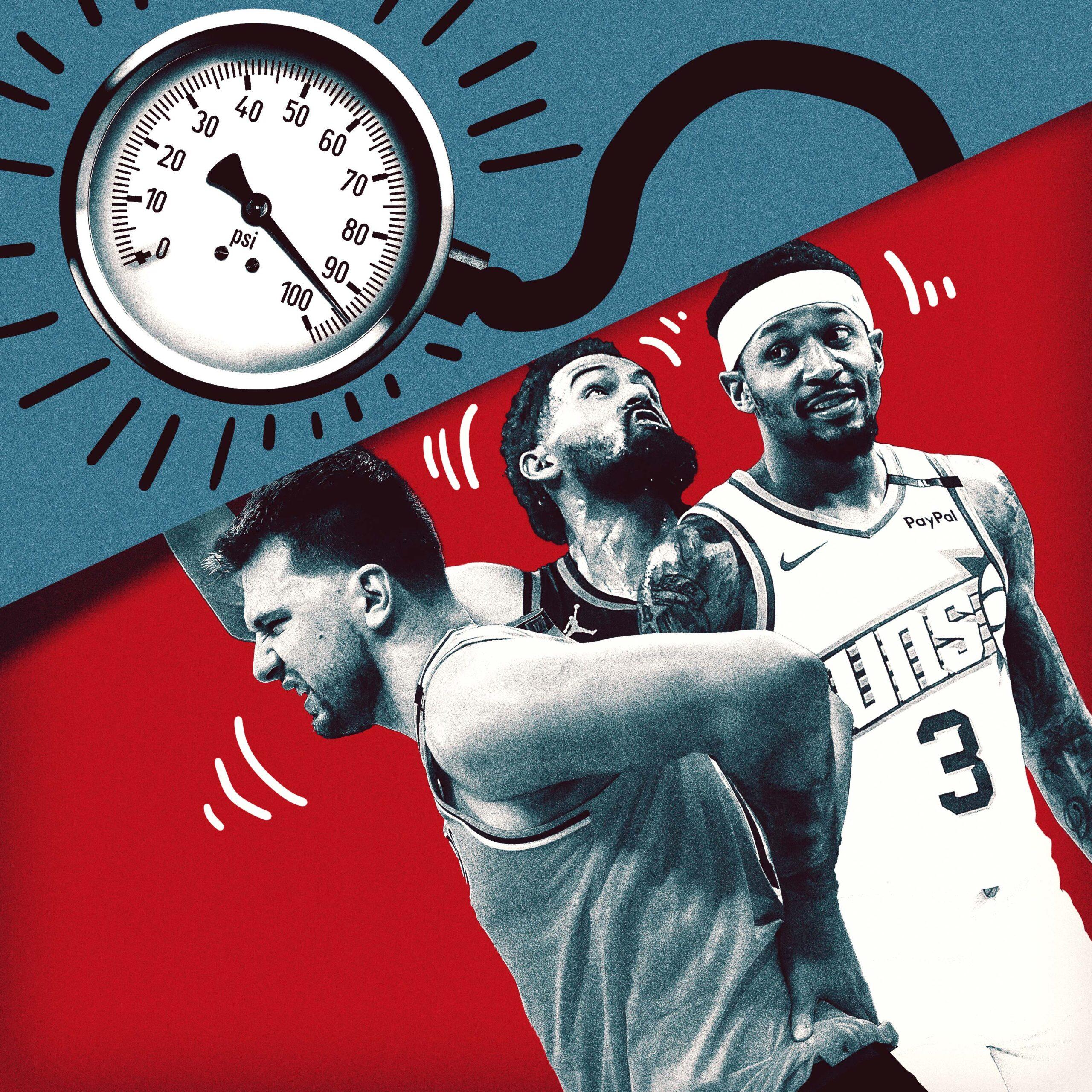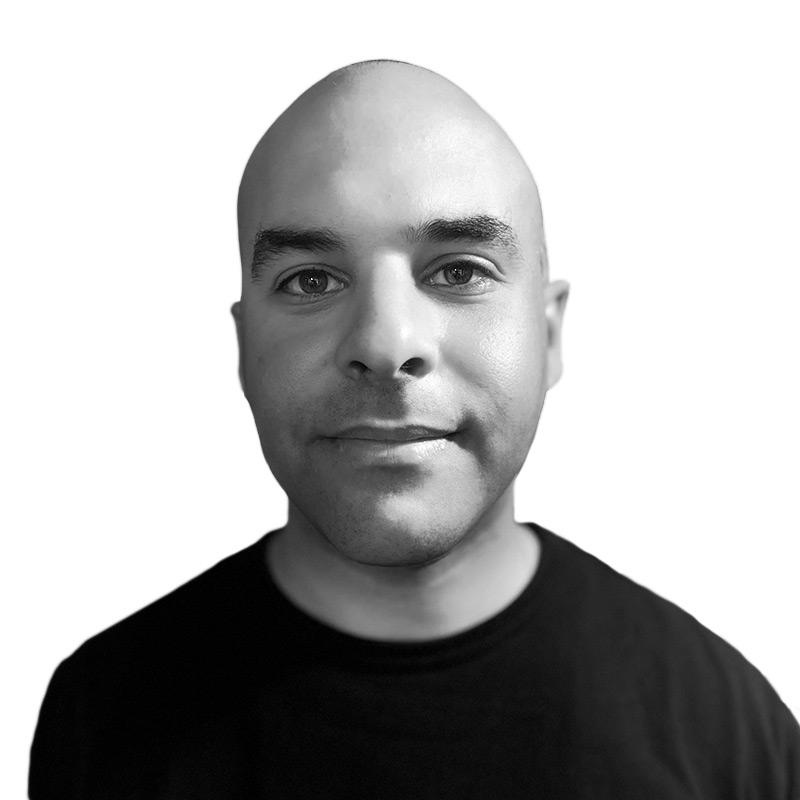
Everyone in the NBA is affected by pressure. The league is slippery, competitive beyond measure, and filled with people who would do anything to get ahead. Of course, there are myriad degrees of stress, and the burden on a scout or 12th man’s shoulders pales in comparison to the massive weight held by a general manager or franchise player. As we start to look ahead to the 2025-26 season, here’s a glance around the league at who’s feeling the most pressure, and how their ability to deal with it will impact the upcoming campaign.
Luka Doncic and Rob Pelinka
The Lakers fascinate me for so many reasons. I can’t decide whether they will be this season’s most pleasant surprise or squandered opportunity, like a Ferrari locked in its own garage. Thanks to Doncic, this is a team that should have championship-or-bust expectations; short of sabotagin its future, they should do whatever it takes to contend for a title every season. Doncic has been great enough to warrant win-now urgency for years. And yet, that’s not what’s happening in Los Angeles. At least not undeniably. Instead, the Lakers have a roster full of Band-Aids.
A disgruntled, increasingly mortal LeBron James creates more questions than answers. Austin Reaves is playing for a new contract and will either be too expensive or too shaky on defense to make sense beyond this season. Marcus Smart is a 31-year-old variable whose cosmic winning plays are offset by an iffy outside shot and chronic injuries that have sapped him of the defensive edge he had in Boston.
Time will tell whether Deandre Ayton is able to establish himself as a long-term pick-and-roll partner who can anchor Los Angeles’s defense, rebound, run the floor, and sacrifice touches and shots without any complaints. Dorian Finney-Smith was lost in free agency (a misplay by Pelinka) and effectively replaced by Jake LaRavia (a fine all-around bench piece who’s yet to play a second of playoff basketball).
This brings us to Doncic. Few players are ever powerful enough to become sole possessors of their own destiny. Maybe three or four emerge in a whole generation. Doncic was one of them until Nico Harrison traded him away and then sullied his character. Doncic responded to the criticism by gracing the cover of Men’s Health magazine this summer. He shed the grief leftover from last season’s trade by assuming ownership of the situation and actively recruiting free agents (like Smart) to his new team.
It’s worth wondering how such sudden and overtly self-conscious behavior comes from someone who, since adolescence, has spent every year of his life as the most confident and preternaturally gifted basketball player his age in the entire world. Doncic’s ability to transcend all of L.A.’s issues is one question. His happiness is another.
Can he reassert himself as the soul-snatching superstar who lifted Dallas to the NBA Finals in 2024? For those who don’t remember, here were Doncic’s per-game averages that year: a league-high 33.9 points, 9.8 assists, and 9.2 rebounds. He drilled a career-best 38.2 percent of the 10.6 3-pointers he launched every night. We’re talking about someone who has the highest career usage rate (35.5 percent) in league history, a take-no-prisoners pick-and-roll maestro who’s mowed through every single defensive scheme that exists.
The pressure on Doncic is unlike what anyone else in the league is facing. Players with his potential can’t afford to spend two straight years in competitive irrelevance. The historical stakes are too high, especially now that he’s the central focus of a storied organization that’s awkwardly pivoting from one first-ballot Hall of Famer to the next. Being the face of the Lakers is different from being the face of just about any other team. It’s a type of fame that’s unachievable anywhere else. LeBron took advantage of that partnership in ways that augmented his celebrity, but the cost was an opportunity to win as many championships as he possibly could; his basketball existence was at the mercy of a front office that inevitably bungled the back nine of his career with one misstep after the next. Will Doncic, who’s yet to even win his first MVP let alone his first title, be comfortable with the same front office handling his future?
Even though he signed a two-year extension that keeps him in L.A. through 2028, it’ll be interesting to see how committed Luka is to a franchise that he did not choose on his own. To that end, Pelinka can’t take Luka for granted, especially when you look around the league and see which teams—the Rockets, Heat, Clippers, [spasming cough fit] Mavericks, etc.—are positioned to offer him a max contract two summers from now.
Maybe everything works out and Doncic is able to mask all of his team’s short-term flaws. But if not, it’ll be interesting to see how fast it takes for him to lose his patience with an organization that’s spent the last few years comfortably skating by on borrowed time.
Jon Horst
Every general manager who’s fortunate enough to build around an unstoppable force does their job under an immense strain that shapes, for better and worse, the rare opportunity they’ve been given.
Horst, the Milwaukee Bucks GM, knows this better than anyone. Very little has worked since he helped mold a championship team around Giannis Antetokounmpo in 2021. Zero draft picks have panned out and his blockbuster trade for Damian Lillard was an overzealous catastrophe. Coming off a summer in which he essentially rolled back last season’s roster (sans its All-Star point guard), Horst has missed the forest for the trees. Keeping Antetokounmpo happy is a significant part of his job description, and there’s no arguing his success rat or the logic behind it. But, largely thanks to some baffling decisions that mistake Giannis for an actual superhero, Horst has reached a point where satisfying his franchise player might not actually be in the franchise’s best interest.
From calling Kyle Kuzma “a plus-plus defender at multiple positions” to some suspect comments about Milwaukee’s 3-point shooting Horst’s positive outlook is based almost entirely on wishful thinking. I’ve written about his shortsighted decision to execute the largest waive-and-stretch in league history just so he could replace Brook Lopez with Myles Turner; it’s a marginal short-term upgrade with adverse financial ramifications, and engenders a strategic plan that essentially boils down to “give Giannis the ball and let him do everything.” That’s more negligent than feasible. As constructed, the Bucks’ ceiling is a first-round playoff exit. The floor is something like what the Philadelphia 76ers just went through last season—minus control of their own draft pick.
At what stage of their denial will someone involved in this doomed partnership realize the second championship Giannis is desperately seeking can’t happen with this roster? Horst still has a few chips to move before the trade deadline—Milwaukee’s first-round pick in 2032 is one of the more valuable assets in the entire league—but it’s hard to envision any deals that can bring in the amount of win-now talent they need to seriously contend.
Somewhat related to all of these issues, I’m struck by how low this team’s payroll is now as it ostensibly does whatever it can to compete at the highest level. The Bucks rank 23rd in payroll, and when you look at their roster it’s not hard to understand why. Antetokounmpo is set to earn over twice as much money as any of his teammates this season. The only other player who can say that is Utah’s Lauri Markkanen, a trade candidate.
It’s almost like Horst purposely spent the offseason doing everything in his power to sabotage the Bucks in a sly effort to convince Giannis he should request a trade. Whether it comes to that or not, all eyes will be on Horst this season. He’ll either need to extract maximum value for one of the league’s brightest stars to kick-start a massive rebuild, or continue to scrape the bottom of the barrel and mine what’s left of his own asset in an effort to turn a fatally flawed roster back into the respectable contender they no longer resemble. Good luck with all that.
Trae Young
When De’Aaron Fox’s new max contract with the San Antonio Spurs was initially reported, my head immediately went to Atlanta, the home of another extension-eligible star point guard. Is Fox better than Young? It’s an interesting debate when you compare their career averages and accomplishments—in two competitively lopsided conferences—and, by a hair, I’d probably side with Young.
But the relationship between Young and Atlanta is far more complicated than the honeymoon stage Fox and San Antonio are still enjoying.
So far, by not giving their franchise player the four-year, $229 million extension Young undoubtedly believes he’s due, the Hawks and their new, aggressive, and shrewd front office are communicating a harsh reality about their current situation: At that price, you need us more than we need you. Atlanta has depended on Young’s talent for years, but right now, in an ironic way, less from their best player may be more. To win big, he must embolden those around him in ways that haven’t consistently happened in even his finest seasons.
While it makes sense to let a star like Trae run as many pick-and-rolls as he wants—especially with 3-point shooters like Kristaps Porzingis, Nickeil Alexander-Walker, and Luke Kennard now on board—it’s even more helpful to underwrite Jalen Johnson, Zaccharie Risacher, and Dyson Daniels’s development by letting them steer the wheel, too.
Since he was drafted, Young’s offensive brilliance and defensive limitations have heavily influenced almost every personnel move the Hawks have made. The results, with three different head coaches and now three general managers, have been unremarkable: Young has not won a playoff series since a magical run to the conference finals in 2021. That doesn’t mean trading him is a prerequisite for a Finals run, but it’ll be nearly impossible for Atlanta to get where it wants to go if Young assumes nearly a third of the cap, with other integral building blocks soon due their own pricey extensions.
Young’s exit from the Hawks may be fait accompli—especially if the New Orleans Pelicans end up forking over a high lottery pick in 2026 that lets Atlanta enter a new era—but the winds of change blow fast in NBA circles. A future very much still exists in which Young and the only team he’s ever played for flourish when he’s surrounded by more talent and better shooters than ever before. Unless he’s willing to take a pay cut, Young’s future home depends on it. And if the Hawks can’t find a trade partner who’s willing to pay Young what he wants without sending back any unwanted long-term salary, there’s also a world where they’ll let him walk as a free agent.
The Entire Cleveland Cavaliers Organization
How could anyone who works for the Cavaliers not feel an immense amount of pressure heading into this season? What we have here is by far the most expensive roster in the league, Finals-or-bust expectations, and the ghost of more than one humiliating playoff exit hovering over everything they do. Cleveland is not just the only organization in the second apron, they’re nearly $20 million over the line!
They bowed out of last year’s playoffs in a humiliating five-game debacle against the Indiana Pacers before any of the more existential questions about their team could even be answered. Can Darius Garland and Donovan Mitchell co-exist defensively? Will Evan Mobley exert a little more force as a scorer? Instead, all we saw was a core that, once again, failed to overcome adversity with their backs against the wall.
The Cavs didn’t overreact, which makes sense. Garland, Mobley, and De’Andre Hunter all missed time during the playoffs and Ty Jerome forgot how to shoot. Swapping Isaac Okoro out for Lonzo Ball was brilliant. (Losing Jerome stings but was a predictable outcome given the cost of everyone else.). But if they can’t conquer one of the weaker Eastern conferences in recent memory with a payroll that already demands reconfiguration, major changes will be coming next summer.
Bradley Beal
Even though Beal is essentially playing for his next contract and can become an unrestricted free agent next summer, there’s no real financial strain on him going into his first season with the Los Angeles Clippers. Regardless of what happens on or off the court, the Phoenix Suns still owe Beal $96.9 million over the next five years. He could move to Hawaii and spend the bulk of his 30s lounging on a beach, and Mat Ishbia would still have to pay him about $20 million every year.
But as someone who B and is coming off two incredibly disappointing seasons as a third wheel who couldn’t figure out how to complement Kevin Durant and Devin Booker, Beal still has a lot to prove. On arguably the league’s deepest team, the 32-year-old slots somewhere above the Clippers’ broad ensemble of aging role players and just below their three All-Star-caliber starters: James Harden, Kawhi Leonard, and Ivica Zubac.
He will spend time as a primary ball handler and end some nights as the team’s scoring leader. But by and large, Beal will be asked to taper his offensive responsibilities and exert maximum effort on the other end. It’s a tricky balance for someone who’s spent most of his career being catered to as a franchise player, but on these Clippers, sacrifice is more essential than production. If Beal can be the efficient double-digit scorer he was in Phoenix while accepting whatever role Ty Lue asks him to fill while eventually helping L.A. go on a deep playoff run, he’ll do more than get another sizable contract—he’ll save his reputation.
Michael Pina
Michael Pina is a senior staff writer at The Ringer who covers the NBA.Source link

